what do you use between your guitar/bass and interface for valve sound?
|
This post was updated on .
hey the gfx,
have decided to bite the tech bullet and enter into the wonderful and frightening world of desktop recording. i treated myself to a focusrite 2i2 at christmas and am sure i can work out what to do with it eventually. however it throws up a dilemma that am not sure how to address. the problem is as follows. previously when i have home recorded, tape multi (old days) and zoom 10 track cd multi (recent old days) i just di-d via whatever effects into the unit to get a rough thing down. when it was worked out i then went to the rehearsal space or studio with big valve amp and played live through it into mic for the real thing. i always considered di-ing a sort of inferior make-do and the through-amp live recording the real deal. now i'm stuck at home for a while and i can only record di, but i want my guitars to sound valves in studio. not an uncommon dilemma i suspect. so thought i would put it to the board. laney will peel the paper from the walls if i fire her up, so she's no go. has to be something with a quality line level out or headphones out at a push. have looked at the orange micro terror, which instincts suggest to me is a naff and hyped toy (maybe i'm being narrow-minded). have been thinking maybe the blackstar ht1w as that has a line output, seems less toy-ish than the orange. reviews favourable and sounds decent in yt clips, limited though that is. there seem to be a lot of mini valve amps now available (new or used) under the £100 mark (my max budget) but my local music shop is pretty miniscule (and further afield not an option atm) re trying before buying. so what do you good people use between wood-steel and microchip to glass up your sound? re amps i like british rock amps, more early 70s laney and orange tones than 80s metal marshall. love fat-assed and course grained distortion, loathe slimy fine grit widdle or doomy chug amps. i've built a few amp sims, ampeg, orange, marshall, and i have the rog condor speaker sim on the way (built but not boxed or tested). maybe they need the rog at the end to sound good, but without it they are ok but not life-changing stomps. generally feel like a bit of grit and a tonestack rather than having the scope and spirit of a real valve burning for you. and maybe i'm being a mojo snob. it happens. so that is it. if anyone can offer advice or recommendations i would be immensely grateful because this is a new science for me. many thanks, tabbycat. martin rushnet on recording tech c1977 (2m00s - 2m45s) factoid: rushnet recorded six tracks (including transmission) with joy division for his fledgling genetic label when the band were looking for their first album deal. wea, who were backing rushnet and genetic, didn't rate them or any of the other unsigned bands he was working with (among them visage, spandau ballet and ultravox, he was sitting on the demo for 'vienna'). the brains at wea told him he should be looking for the new angelic upstarts. so, much to his annoyance, he had to let them go. from which point the idea for factory and hannett producing the first album grew. the rest, as they say, is history. full story in simon reynolds brilliant 'totally wired'. |
|
Administrator
|
It's really hard to get the old school sound with DI. DI has such an immediate attack response, it gives it an extra crispy sound that often seems "plastic" or cheesey. You may want to get creative and figure out how to slow your attack a little bit. A compressor will be very useful. If you adjust the EQ to be in the ballpark frequency range of your desired amp, you're that much more convincing.
As I said in the fuck OD thread, I did some DI recording with that and it's pretty nice for a few reasons. 1: the exploding amp control can be adjusted to sorta simulate the attack of a tube amp 2: the gain range is very wide, from completely clean (with plenty of output range to work with), to pretty crazy 3: the hi cut is very useful to roll of some of the highs that may be too present with your DI sound Overall I think it's much more important to find a sound that you're happy to work with, rather than trying to emulate a given amp with DI which is very difficult. Try fuzz pedals straight into the DI. Try all of the gear that you already have 
|
Re: what do you use between your guitar/bass and interface for valve sound?
|
In reply to this post by tabbycat
A Valvecaster or a Boob Tube should help you get some tube saturation and tube sag.
If you also build a charge pump and increase the Plate voltage (keep Heater power at 12v) you will get more headroom... (recommended, unless you want a lot of sag and maximum grit...) |
|
In reply to this post by tabbycat
When we recorded recently, I had to DI so just had my pedalboard and couldn't use my valve amp [A stupidly loud but nicely crunchy Engl]. It wasn't a complete fail, and most peeps won't notice the 'flat' tone, but I know it could be better. Anyway, I digress...
A while ago, I bought a cheap Line 6 POD and although it was pretty crap through an amp, I got some decent results using it with my 2i2 at home, with the built in amp sims. These were competely meh through an amp, but seemed to work pretty well via a DI and did have some of that dynamic response you get from a decent valve amp. Ok, you might not *own or want to own a Line 6 thing, but I went from 'Why did I waste...' to 'Ah, this is ok', so I might keep it. :) Another option is to try some of the VST amp sims in Cubase. I haven't tried any as yet, but the Line 6 thing is just doing the same thing and was surprisingly ok. You can't beat a real valve [pre] amp with real timbre and dynamic response but I think there is stuff out there that can emulate it to a reasonable degree. *You sound English, so if you anywhere near Manchester, you can borrow the Line 6 for a punt. |
|
Administrator
|
i actually have the same interface. i use the di out from my mesa m6, which has a tube preamp, if i don't want to go through the hassle of micing my cabinet. i use reason 7 for recording either way, which is fantastic software IMHO. if you're amp has tubes and has a di out i would go that way.
ed, i hear you on having a stupid loud amp. my mesa is 600 mesa boogie watts, and i can't really even go to 1 in the house without shaking the house. and dear god the thunder that comes out of it when i run a fuzz in front of it, its absolutely glorious. not going to lie i still do it anyways, totally worth it. 
|
Re: what do you use between your guitar/bass and interface for valve sound?
|
In reply to this post by tabbycat
If you are considering something in the category of a Line 6 Pod
 . .
Then nothing beats the Yamaha THR series amps  Not only does it sound great, but it is also a vey usable amp-sim/recording amp, with 10 watts of power, and it functions as a guitar interface/soundcard via USB. It also handles pedals great and breaks up as expected when pushed. Only thing is: The Line 6 Pods you can get for free, if you know anyone who has one. They will gladly give it away, and later you will be very pleased to do the same...  |
|
What about these????
Hotone British Invasion (one in a series of amp emulators): 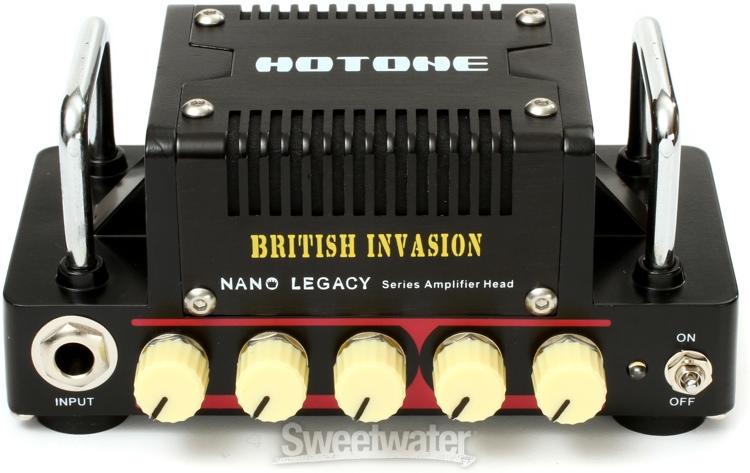 |
Re: what do you use between your guitar/bass and interface for valve sound?
|
In reply to this post by tabbycat
Tabby...
I have been recording longer than I have been gigging. I have owned pro-recording studios, and worked at Grammy-winning studios in Hollywood for years. I listened to your GenX example (always a good idea to include one) and I think for that bass sound all you need is a good amp emulator plugin. It sounds to me like an easy thing to find with the right one, like I hear Amplitube 3 is really good. I could give you a lot of bad ideas that would probably get you close but I don't think it is what you want in the long run. Things like taking a DI from your amp. If you want to use effect boxes, I would recommend a good speaker emulator. I think that (plus amplitube) will get you close than miking your amp at low volume or taking a DI-out from amp (if it has it). I think what you are really looking for is that cooking tubes pushing a lot of air sound. Look for plugins like the LA-2A limiter and the Pultec EQs. Compressor plugins with tube pre-amp sections work pretty well, too. What DAW are you using? |
Re: what do you use between your guitar/bass and interface for valve sound?
|
In reply to this post by tabbycat
Hi Tabbycat,
I have the Blackstar HT-1 head, and the speaker emulated output works pretty well direct into a recording interface. The amp eq (just Blackstar's ISF control) is a bit limited, but the amp takes pedals pretty well and it's easy enough to put extra eq beforehand. I also use a Palmer PDI-03 with bigger valve amps, which is a combined speaker simulator and load box. That will also let you record direct without speakers. Neither really gives you the feel of playing through real speakers, or moving real air, but they can get close enough when you can't make noise, and, in my opinion, they can sound better in a recording than a poorly mic'ed amp in an acoustically bad room. I've also had pretty reasonable results from speaker simulated DI's and home made load boxes (a couple of 20 Ohm, 10w resistors soldered in parallel on the end of a jack plug, to give an approximate 8 - ok 10 - ohm load for a home-built 4-watter - air cooling being enough for the heat dissipation in this case). You might be able to rig up something DIY for your Laney as a low-cost option - I've even seen references to using toaster elements as the resistive load for bigger amps, and lightbulbs as reactive elements too - could be a whole new world of DIY and ancillary cookery opening up there. Cheers, all the best. |
|
In reply to this post by tabbycat
Yet another DIY option, the isolation cabinet. Plans abound on the internets.
Mine is made of 2" thick MDF just large enough for a Princeton and a Shure 57 to fit  
|
Re: what do you use between your guitar/bass and interface for valve sound?
|
A couple of notes about iso-boxes. I have one which I think is very good - the Rivera Silent Sister. It is well designed for two reasons -
(1) you want to avoid the boxy sound of standing waves by eliminating parallel reflections into the back of the mic. The SS uses a slanted speaker baffle so sound hits the cabinet walls at an angle. I have seen a lot of DIY designs where people try to build slanted walls inside the box but the easier answer is to slant the speaker baffle. (2) some iso-boxes sound boxy (damping factor) because they don't let the speaker breathe. The SS has small openings at the bottom/back for air (bass) relief. There is a labyrinth so you don't get a lot of sound leakage and the opening goes down to the wall by the floor so you barely hear it. http://www.rivera.com/product/cabinets/silent-sister/ It also takes two mics. I use an SM-57 and a ribbon mic which I made DIY that has great low end. http://diyribbonmic.com/diykits/ |
Re: what do you use between your guitar/bass and interface for valve sound?
|
This post was updated on .
In reply to this post by tabbycat
It's certainly not cheap, but I use a Verellen Meatsmoke Pre into a Scarlett 2i2 and get a really nice tone out of it. Best part? Works for guitar and bass. When I run it into the 2i2, I have the gain on the 2i2 input at almost zero.
I just got a darkglass b7k, which has DI out, but haven't tried it out with the scarlett yet. I've ran it into my amp for use as an overdrive/distortion but it's tough to tell how tubey it sounds given that I'm running it into an all tube bass amp. For some parts where the Meatsmoke can't get the tone I want, we do amp > mic > 2i2. Ex: we use an old Fender Champ with a 8" driver, or an Orange Tiny Terror on half power into a 12" driver, and mic them with condensers or a SM57. Also, do some reading on "re-amping". FWIW, my band uses the 2i2 for all of our recording except drums where we use a USB mixer to get all the drum mics in on separate tracks. |
Re: what do you use between your guitar/bass and interface for valve sound?
|
In reply to this post by motterpaul
Hey Paul, is that "labyrinth" you refer to a sound trap of similar design to this?
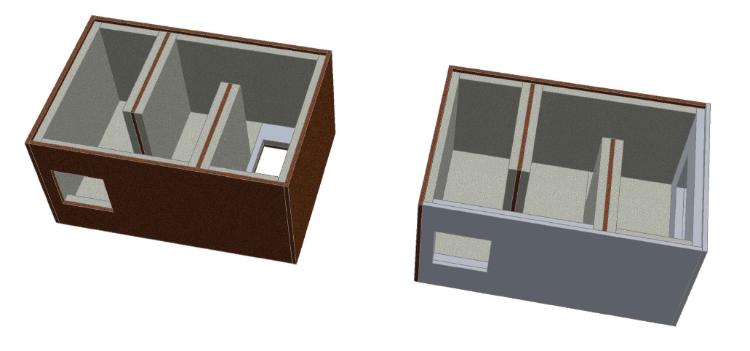
|
Re: what do you use between your guitar/bass and interface for valve sound?
|
This post was updated on .
Yes, a similar concept. But the Rivera gives the speaker section a little more room and tightens up the labyrinth, which is also largely filled with sound absorption (stuff that looks like fiberglass wool, but is something less toxic).
Also - take the first platform on the left (below the open square where the mic cable input panel will be installed) and angle that down so the speaker sits at about 22-degrees from flat and CLOSE that baffle off. You only need to relieve the air pressure from the back side of the speaker - not the front. You get the same air relief. QUICK 'N DIRTY PIC: 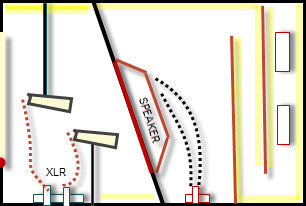
|
Re: what do you use between your guitar/bass and interface for valve sound?
|
Ok, thanks! I saw this trap design on a DI site and was looking to use it for my forced-air intake and outtake vents in my band room but didn't want to jump in to building them before hearing from others on how they worked. Just a coincidence you mentioned it on here before I went and did my due diligence.
|
Re: what do you use between your guitar/bass and interface for valve sound?
|
For air conditioner air intake these work just fine - if that is what you mean.
I like the split coil ACs, though. The only holes you need are for cables & copper lines - no air ducts. They are also heaters. 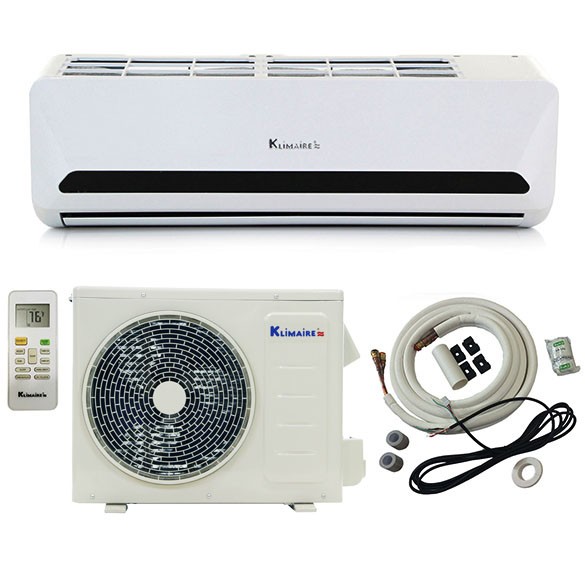 Getting a little off-topic tho, I don't want to steal the thread away. |
|
Administrator
|
In reply to this post by negativefx
Man those ISO boxes are a great idea!! I've been spoiled by my friend's very nice walk-in ISO booth but might have to build one of those boxes for home
|
|
In reply to this post by Travis
apologies in advance for this all-in-one mega reply post but the people keep adding to this thread with inspiring and helpful ideas which i feel duty bound to honour with thanks and a response.
whatever happened to good old-fashioned trolling, cat memes and porn? the internet is really going to shit these days. thanks for the advice, travis. the fuck is out of my range for the foreseeable but will look at what i can achieve with a cheap or diy compressor. will also keep experimenting with the diy amp in a box things I have bult (rogs, catlinbreads, eqd, etc). and am looking at buying a cheap ht1 for either the emulated out, which people say is pretty acceptable for di, or to put in an isolation cab. there is also a cheap rehearsal place about five mins walk from me so I could put that amp and my guitar in a shopping trolley and wheel it down there to record noisy (blackstar can go through any speaker cab). will also look at a dummy load for my laney 30w, which is to big to take anywhere atm, but my best amp. but the ht1 looks the best all round option atm. jack of all if master of none. thanks for the recommendation, neil. am thinking about mini valve builds but am also aware that once i buy decent valves etc and a transformer to give enough clean reliable headroom, i will be getting into the kind of money that will buy something decent and ready built. but still curious. do these things dummy load or straight in? which is your favourite? @ed thanks for the tip re the modelling option. I have no snobbery re line 6 etc. I have a couple of behringers on my board. if it works I’m up for it, will try to find one to borrow and try. wrong end of the country for a loan (south coast) but thanks for the offer. @frank thanks for the link. have you tried these with any success? thanks for the suggestions mp. re di from amp. am looking at diy or cheap dummy load and cab sim options. I love my laney but it is a non-starter in a flat. but if I could record through it silently that would be sweet. also looking at getting the ht1 and building a little isolation cabinet for it. it’s a4 size (uk paper size) so perfect for that. laney too big and loud to do that with really. what do you recommend as a good affordable (cheap new or used or buildable) speaker emulator? ‘cooking tubes pushing hot air’ very much it. re daw, I have the focusrite 2i2 with whatever package that comes with ableton live-lite plus this stuff (this site won't let me post a link to the gak focusrite 2i2 page, spam words reject, but on that page it lists the plug ins, they all come with them). I am yet to set it up (three months later) as am a bit daunted by the whole idea really, am not at all a computer person. but there seems to be enough of a certain quality to get by ok, according to all reliable accounts I have read/heard re the software side of the package. re your comments on iso boxes, am on a no-budget so it has to be kitchen built on pennies, but your links look interesting inspiration. maybe an iso box thread is long overdue. there seems to be a lot of interest in them, and knowledge about them, that could be joined up to produce a good go to thread for gfx. hey sp, thanks for the comment. your ht1 comments seem to chime with what I have found out about it. what do you do for reverb if your is the ht1 rather than ht1r? reverb in sometimes sounds deeply crap. or do you add afterwards? palmer seems to be more luxury than I can pay for but would like to hear more re you recommendations for a diy dummy load that works without tone-killing. do you have a link to a diy design or layout? re resistive load, I have a few heat-sink things from computers that cover the processor and look like weird fan-buildings. they might be good in that role. designer to dissipate heat quickly. smooth edge to attach to component. thanks for the tip and photos hmh, that look amazing and is something very much on my agenda. do you have a link to the plans for that one. it looks like the size i will be aiming for. any tips for using? sm57 or equivalent seems favourite for mic. btw, is anyone up for a separate and dedicated ‘school me on iso boxes’ separate thread? seems to be an appetite for it. |
Re: what do you use between your guitar/bass and interface for valve sound?
|
In reply to this post by tabbycat
Hi Tabbycat,
Well, here's a picture of a couple of load "boxes" I've knocked up - both use 10W rated resistors, giving a nominal 20W max input - well below the wattage of any amp I've used them with. I haven't needed any extra heat sinking, but, as I say, I've only used them with 1 or 4 watt amps. Attaching your heat sinks wouldn't hurt (unless you touch them when they're hot, har, har). 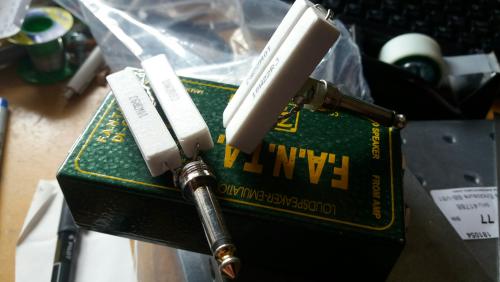 One has two 3r9s in series, the other two 22rs in parallel: I just happened to have these resistors in the bits box. The box underneath is a passive speaker emulator/DI that I bought on eBay some years ago for peanuts. As far as dynamic DI solutions go, it's about as inspiring as a sock full of warm custard, but it does work for getting line-level, de-fizzed signal from an amp's speaker output. You still need some kind of load, though, to avoid frying OT/valves - hence the natty resistor/jack plug combos. The red Behringer DI box will do the same trick at pocket money prices, too. Again, still needs a load. There's a thread about the Palmer on FSB (http://www.freestompboxes.org/viewtopic.php?f=2&t=4939) - this uses 4 27r resistors in parallel as the load, with a great big heatsink to handle power output up to 100w. There's also an inductor in there - presumably to make the load a bit more "speaker-like". And there's a tone-shaping network too to do the cab sim stuff. The gut shots look fairly straightforward/simple, though I guess you'd need to take care choosing components with suitable tolerances for the high-power bits. If you do some web searches looking for combinations of reactive, amp, load box, power soak and so on you'll most likely turn up everything I've found: I usually use image search these days, then follow the page links from likely looking pictures. I didn't really find any fully-formed DIY projects when I was looking a couple of years ago, but there are plenty of hints out there. My HT1 has reverb. It's ok, though I usually record without, as there's nothing like reverb to make guitar disappear in the mix. It's nice to have, but I wouldn't miss it on the HT1 if it wasn't there. The "overdrive" on the HT1 is very noisy. Again, nice to have, but by no means essential. |
|
In reply to this post by tabbycat
Mine is a 25" cube, most similar to these plans http://www.amptone.com/diyisobox.htm I've tried ribbon and condenser mics in there with the SM57 and as described above the results are not like what you'd get in a nice room. For close-mic'd SM57 it works great. You can turn the lid to let some air in, but that defeats the purpose and lets all the rawk out. |
«
Return to Open Chat
|
1 view|%1 views
| Free forum by Nabble | Edit this page |

